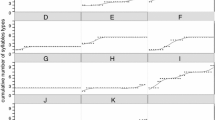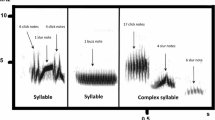Abstract
The complexity of bird song could serve as an indicator of male quality. Repertoire size is a widely used measure of song complexity. However, little is known about the influence of repertoire size on the song sequencing patterns. At the same time, individual variability of song sequencing and its relation to repertoire size could be important for intraspecific communication. It is unlikely for an individual to count and compare full repertoires. Instead, they are more likely to rely on patterns of song performance. I analyzed the intraspecific variability in the song sequencing and its relation to the repertoire size in the Grey-crowned Warbler (Seicercus tephrocephalus). Advertising vocalization of males with larger repertoires turned out to be more determined and predictable than of the males with smaller repertoires. This pattern might reflect different learning abilities of males with different repertoire sizes. Learning abilities, in turn, might reflect male quality and/or age. However, these patterns could not be evaluated by analyzing short song sessions and it is very unlikely for other individuals to estimate them. However, these patterns influenced the other parameters of song organisation which could be estimated from short song sessions (such as versatility and song switching rate). Thus, for other individuals the latter may serve as an indicator of a male’s repertoire size.
Zusammenfassung
Beziehungen zwischen der Repertoiregröße und der Organisation von Gesangsphasen beim Grauscheitel-Laubsänger ( Seicercus tephrocephalus )Die Komplexität von Vogelgesang könnte als Anzeiger der Qualität von Männchen dienen. Die Repertoiregröße ist ein weitverbreitetes Maß für die Gesangskomplexität. Über den Einfluss der Repertoiregröße auf die Gesangsreihenfolgemuster ist jedoch nur wenig bekannt. Gleichzeitig könnten die individuelle Variabilität der Gesangsreihenfolge und ihre Beziehung zur Repertoiregröße für die intraspezifische Kommunikation von Bedeutung sein. Es ist unwahrscheinlich, dass Individuen zählen und vollständige Repertoires vergleichen. Stattdessen ist es wahrscheinlicher, dass sie Muster der Gesangsdarbietung heranziehen. Ich habe die intraspezifische Variabilität in der Gesangsreihenfolge und ihre Beziehung zur Repertoiregröße beim Grauscheitel-Laubsänger (Seicercus tephrocephalus) analysiert. Werbegesänge von Männchen mit größeren Repertoires erwiesen sich als festgelegter und vorhersehbarer als die von Männchen mit kleineren Repertoires. Dieses Muster könnte Unterschiede im Lernvermögen zwischen Männchen mit unterschiedlichen Repertoiregrößen widerspiegeln. Das Lernvermögen könnte wiederum die Qualität und/oder das Alter der Männchen reflektieren. Diese Muster konnten jedoch nicht ausgewertet werden, wenn nur kurze Gesangsphasen analysiert wurden, und es ist unwahrscheinlich, dass andere Individuen sie einschätzen können. Diese Muster beeinflussten jedoch die anderen Parameter der Gesangsorganisation, die anhand von kurzen Gesangsphasen eingeschätzt werden konnten (z. B. Vielseitigkeit und die Rate der Gesangswechsel). Daher könnten diese Parameter anderen Individuen als Anzeiger der Repertoiregröße eines Männchen dienen.




Similar content being viewed by others
References
Airey DC, DeVoogd TJ (2000) Greater song complexity is associated with augmented song system anatomy in zebra finch. NeuroReport 11:2339–2344
Alström P, Olsson U (1999) The golden–spectacled warbler: a complex of sibling species from Sichuan Province, China. Ibis 141:545–568
Alström P, Olsson U (2000) Golden–spectacled warbler systematics. Ibis 142:495–500
Alström P, Olsson U, Lei F (2013) A review of the recent advances in the systematic of the avian superfamily Sylvioidea. Chin Birds 4:99–131
Benjamini Y, Hochberg Y (1995) Controlling the false discovery rate: a practical and powerful approach to multiple testing. J R Stat Soc Ser B 57:289–300
Boogert NJ, Giraldeau L-A, Lefebvre L (2008) Song complexity correlates with learning ability in zebra finch males. Anim Behav 76:1735–1741
Briefer E, Osiejuk T, Rybak F, Aubin T (2010) Are bird song complexity and song sharing shaped by habitat structure? An information theory and statistical approach. J Theor Biol 262:151–164
Buchanan KL, Spencer KA, Goldmith AR, Catchpole CK (2003) Song as an honest signal of past developmental stress in the European starling (Sturnus vulgaris). Proc R Soc Lond B 270:1149–1156
Byers BE, Kroodsma DE (2009) Female mate choice and songbird song repertoire. Anim Behav 77:13–22
Catchpole CK, Slater PJB (2008) Bird song: biological themes and variations, 2nd edn. Cambridge University Press, Cambridge, p 335
Da Silva ML, Piqueire JRC, Vielliard JME (2000) Using Shannon entropy on measuring the individual variability in the rufous-bellied Thrush Turdus rufiventris vocal communication. J Theor Biol 207:57–64
DeVoogd TJ (2004) Neural constraints on the complexity of avian song. Brain Behav Evol 63:221–232
Falls JB (1969) Functions of territorial song in the white-throated sparrow. In: Hinde RA (ed) Bird vocalizations. Cambridge University Press, Cambridge, pp 207–232
Garamszegi LZ, Balsby TJS, Bell BD, Borowiec M, Byers BE, Dragonoiu T, Eens M, Forstmeier F, Galeotti P, Gil D, Gorissen L, Hansen P, Lampe HM, Leitner S, Lontkowski J, Nagle L, Nemeth E, Pinxten R, Rossi JM, Saino N, Tanvez A, Titus R, Török J, Van Duyse E, Møller AP (2005) Estimating the complexity of bird song by using capture–recapture approaches from community ecology. Behav Ecol Sociobiol 57:305–317
Garamszegi LZ, Zsebök S, Török J (2012) The relationship between syllable repertoire similarity and pairing success in a passerine bird species with complex song. J Theor Biol 295:68–76
Gentner T (2007) Mechanisms of temporal auditory pattern learning in song birds. Lang Learn Dev 3:1–22
Gil D, Gahr M (2002) The honesty of bird song: multiple constraints for multiple traits. Trends Ecol Evol 17:133–141
Gil D, Slater PJB (2000) Multiple song repertoire characteristics in the willow warbler (Phylloscopus trochilus): correlations with female choice and offspring viability. Behav Ecol Sociobiol 47:319–326
Gil D, Cobb JLS, Slater PJB (2001) Song characteristics are age dependent in the willow warbler, Phylloscopus trochilus. Anim Behav 62:689–694
Handel S, Todd SK, Zoidis AM (2012) Hierarchical and rhythmic organization in the songs of humpback whales (Megaptera novaeangliae). Bioacoustics 21:141–156
Hasselquist D, Bensch S, von Schantz T (1996) Correlation between male song repertoire, extra-pair paternity and offspring survival in the great reed warbler. Nature 381:229–232
Johansson US, Alström P, Olsson U, Ericson PG, Sundberg P, Price TD (2007) Build-up of the Himalayan avifauna through immigration: a biogeographical analysis of the Phylloscopus and Seicercus. Evolution 61:324–333
Kershenbaum A (2013) Entropy rate as a measure of animal vocal complexity. Bioacoustics 23:195–208
Kershenbaum A, Blumstein DT, Roch MA, Akcay C, Backus G, Bee MA, Bohn K, Cao Y, Carter G, Casar C, Coen M, DeRuiter SL, Doyle L, Edelman S, Ferrer ICR, Freeberg TM, Garland EC, Gustison M, Harley HE, Huetz C, Hughes M, Hyland Bruno J, Ilany A, Jin DZ, Johnson M, Ju C, Karnowski J, Lohr B, Manser MB, McCowan B, Mercado E, Narins PM, Piel A, Rice M, Salmi R, Sasahara K, Sayigh L, Shiu Y, Taylor C, Vallejo EE, Waller S, Zamora-Gutierrez V (2014) Acoustic sequences in non-human animals: a tutorial review and prospectus. Biol Rev Camb Philos Soc 91:13–52
Lampe HM, Espmark YO (2003) Mate choice in pied flycatchers Ficedula hypoleuca: can females use song to find high-quality males and territories? Ibis 145:24–33
Langmore NE (1997) Song switching in monandrous and polyandrous dunnocks, Prunella modularis. Anim Behav 53:757–766
Lemon RE, Dobson CW, Clifton PG (1993) Songs of American redstarts (Setophaga ruticilla): sequencing rules and their relationships to repertoire size. Ethology 93:198–210
Martens J, Eck S, Päckert M, Sun YH (1999) The golden-spectacled warbler Seicercus burkii a species swarm (Aves: Passeriformes: Sylviidae). Part 1. Zool Abh (Dresd) 50:282–327
Martens J, Eck S, Päckert M, Sun YH (2003) Methods of systematic and taxonomic research on passerine birds: the timely example of the Seicercus burkii complex (Sylviidae). Part 2. Bonner Zool Beitr 51:109–118
McGregor PK, Krebs JR, Perrins CM (1981) Song repertoires and lifetime reproductive success in the great tit (Parus major). Am Nat 118:149–159
Nowicki S, Searcy WA, Peters S (2002) Brain development, song learning and mate choice in birds: a review and experimental test of the “nutritional stress hypothesis”. J Comp Physiol 188:1003–1014
Okanoya K (2013) Finite-state song syntax in Bengalese finches: sensorimotor evidence, developmental processes, and formal procedures for syntax extraction. In: Bolhuis JJ, Everaert M (eds) Birdsong, speech, and language. Exploring the evolution of mind and brain. The MIT Press, London, pp 229–242
Päckert M, Martens J, Sun YH, Veith M (2004) The radiation of the Seicercus burkii complex and its congeners (Aves: Sylviidae): molecular genetics and bioacoustics. Org Div Evol 4:341–364
Riebel K (2009) Song and female mate choice in Zebra Finch: a review. Adv Stud Behav 40:197–238
Ritchison G (1988) Song repertoires and the singing behavior of male northern cardinals. Wilson Bull 100:583–603
Ruxton GD, Schaefer HM (2011) Resolving current disagreements and ambiguities in the terminology of animal communication. J Evol Biol 24:2574–2585
Samotskaya VV, Opaev AS, Ivanitskii VV, Marova IM, Kvartalnov PV (2016) Syntax of complex bird song in the large-billed reed warbler (Acrocephalus orinus). Bioacoustics. doi:10.1080/09524622.2015.1130648
Scharff C, Nottebohm F (1991) A comparative study of the behavioral deficits following lesions of various parts of the Zebra Finch song system: implication for vocal learning. J Neurosci 11:2896–2913
Schwabl H, Dowling J, Baldassarre DT, Gahr M, Lindsay WR, Webster MS (2015) Variation in song system anatomy and androgen levels does not correspond to song characteristics in a tropical songbird. Anim Behav 104:39–50
Searcy WA, Beecher MD (2009) Song as an aggressive signal in songbirds. Anim Behav 78:1281–1292
Searcy WA, Yasukawa K (1990) Use of the song repertoire in intersexual and intrasexual context by male red-winged blackbirds. Behav Ecol Sociobiol 27:123–128
Searcy WA, McArthur PD, Yasukawa K (1985) Song repertoire size and male quality in song sparrows. Condor 87:222–228
Spencer KA, Buchanan KL, Leitner S, Goldsmith AR, Catchpole CK (2005) Parasites affect song complexity and neutral development in a songbird. Proc R Soc Lond B 272:2037–2043
Woolley SMN, Rubel EW (1997) Bengalese finches Lonchura striata domestica depend upon auditory feedback for the maintenance of adult song. J Neurosci 17:6380–6390
Acknowledgments
I am grateful to Veronika Samotskaya, Meisi Liu, Kang Zujie and Shurong Tian for their support during field study. I thank Martin Päckert for providing advice in identification of the study species and Nikita Chernetsov for editing the English and providing helpful comments. The study was supported by the Russian Foundation for Basic Research (project no. 11-04-01302-a).
Author information
Authors and Affiliations
Corresponding author
Additional information
Communicated by M. Naguib.
Electronic supplementary material
Below is the link to the electronic supplementary material.
Rights and permissions
About this article
Cite this article
Opaev, A. Relationships between repertoire size and organization of song bouts in the Grey-crowned Warbler (Seicercus tephrocephalus). J Ornithol 157, 949–960 (2016). https://doi.org/10.1007/s10336-016-1342-6
Received:
Revised:
Accepted:
Published:
Issue Date:
DOI: https://doi.org/10.1007/s10336-016-1342-6




